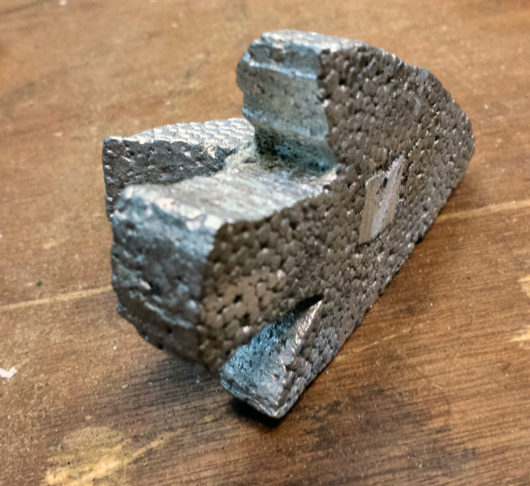Not known Facts About Stahl Specialty Company
Not known Facts About Stahl Specialty Company
Blog Article
Rumored Buzz on Stahl Specialty Company
Table of ContentsStahl Specialty Company - The FactsNot known Factual Statements About Stahl Specialty Company Getting My Stahl Specialty Company To WorkThe Facts About Stahl Specialty Company Uncovered4 Easy Facts About Stahl Specialty Company Described
The refined difference hinges on the chemical material. Chemical Contrast of Cast Aluminum Alloys Silicon promotes castability by reducing the alloy's melting temperature level and enhancing fluidity during spreading. It plays a critical role in enabling detailed molds to be loaded properly. Additionally, silicon adds to the alloy's stamina and put on resistance, making it important in applications where sturdiness is critical, such as auto components and engine parts.It likewise boosts the machinability of the alloy, making it easier to refine right into finished products. In this method, iron contributes to the general workability of aluminum alloys.
Manganese adds to the stamina of aluminum alloys and boosts workability. It is typically made use of in wrought aluminum products like sheets, extrusions, and accounts. The existence of manganese aids in the alloy's formability and resistance to splitting during manufacture processes. Magnesium is a lightweight aspect that supplies toughness and influence resistance to aluminum alloys.
Zinc improves the castability of light weight aluminum alloys and assists manage the solidification procedure throughout spreading. It improves the alloy's strength and solidity.
The Best Guide To Stahl Specialty Company
Since aluminum-silicon alloys have good spreading homes, high gas residential or commercial properties, simple procedures, and outstanding corrosion resistance, aluminum-silicon alloys are most generally utilized in the die-casting industry in your home and abroad. At the exact same time, aluminum-silicon alloys are additionally relatively very early and widely acknowledged alloys created and utilized in die-casting. After constant study and renovation, the majority of the current global mainstream aluminum-silicon alloys have actually been settled and are absolutely nothing greater than A356, A360, A380, ADC12, B390, and A413.
The key thermal conductivity, tensile strength, yield stamina, and prolongation differ. Among the above alloys, A356 has the highest possible thermal conductivity, and A380 and ADC12 have the lowest.

A Biased View of Stahl Specialty Company
In precision casting, 6063 is well-suited for applications where complex geometries and high-quality surface area finishes are paramount. Instances consist of telecommunication enclosures, where the alloy's superior formability allows for sleek and aesthetically pleasing styles while keeping architectural integrity. Similarly, in the Lighting Solutions industry, precision-cast 6063 parts develop elegant and reliable lighting fixtures that need intricate forms and great thermal performance.
(https://leetcode.com/u/stahlspecialc/)
It causes a finer surface coating and better corrosion resistance in A360. The A360 shows remarkable elongation, making it perfect for facility and thin-walled elements. In accuracy casting applications, A360 is well-suited for sectors such as Customer Electronics, Telecommunication, and Power Devices. aluminum metal casting. Its enhanced fluidness permits elaborate, high-precision parts like smartphone cases and interaction tool housings.

In precision casting, aluminum 413 beams in the Customer Electronics and Power Devices markets. It's commonly made use of to craft complex components like mobile phone real estates, cam bodies, and power tool housings. Its accuracy is impressive, with tight tolerances as much as 0.01 mm, making sure flawless product assembly. This alloy's premium corrosion resistance makes it an outstanding choice for outside applications, ensuring durable, resilient items in the mentioned markets.
The Ultimate Guide To Stahl Specialty Company
As soon as you have made a decision that the aluminum die casting process is suitable for your job, a vital following action is selecting one of the most appropriate alloy. The aluminum alloy you choose will significantly impact both the casting procedure and the buildings of the last product. As a result of this, you need to make your decision carefully and take an enlightened approach.
Figuring out the most suitable light weight aluminum alloy for your application will certainly indicate evaluating a broad array of characteristics. These relative alloy characteristics adhere to the North American Pass Away Casting Organization's standards, and we've separated them into 2 classifications. Foundry near me. The very first classification addresses alloy qualities that influence the manufacturing process. The 2nd covers attributes influencing the properties of the last item.
The alloy you choose for die spreading directly influences a number of aspects of the casting procedure, like just how very easy the alloy is to deal with and if it is susceptible to casting defects. Hot cracking, click here for more additionally referred to as solidification splitting, is a normal die casting defect for aluminum alloys that can cause interior or surface-level rips or fractures.
The Only Guide to Stahl Specialty Company
Certain light weight aluminum alloys are extra susceptible to hot splitting than others, and your selection ought to consider this. An additional usual defect found in the die casting of aluminum is die soldering, which is when the actors sticks to the die walls and makes ejection challenging. It can damage both the cast and the die, so you should search for alloys with high anti-soldering homes.
Deterioration resistance, which is currently a remarkable attribute of light weight aluminum, can differ substantially from alloy to alloy and is a vital characteristic to consider relying on the environmental conditions your item will be exposed to. Put on resistance is one more residential property frequently sought in light weight aluminum items and can differentiate some alloys.
Report this page